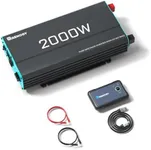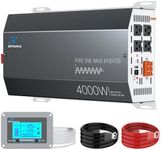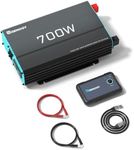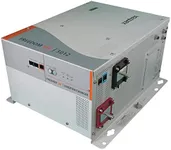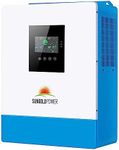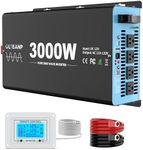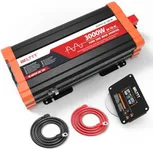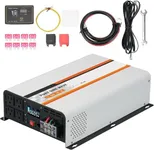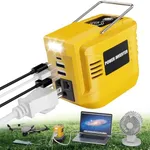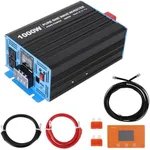Buying Guide for the Best Pure Sine Wave Inverters
When choosing a pure sine wave inverter, it's important to understand that this device converts direct current (DC) from sources like batteries or solar panels into alternating current (AC) that can be used to power household appliances and electronics. Pure sine wave inverters provide a smooth and consistent wave output, which is crucial for sensitive electronics and appliances. To select the best inverter for your needs, you should consider several key specifications that will ensure compatibility and efficiency for your intended use.Power Output (Wattage)Power output, measured in watts (W), indicates the maximum amount of power the inverter can supply. This is important because it determines what and how many devices you can run simultaneously. Inverters typically come in various power ratings, such as 300W, 1000W, or 3000W. For light use, such as charging small electronics, a lower wattage inverter (300W-500W) may suffice. For running household appliances like refrigerators or microwaves, a mid-range inverter (1000W-2000W) is more appropriate. For heavy-duty use, such as powering multiple large appliances or tools, a high-wattage inverter (2000W and above) is necessary. Assess your power needs by adding up the wattage of all devices you plan to use simultaneously and choose an inverter that can handle that load.
Input VoltageInput voltage refers to the voltage level that the inverter requires from the power source, typically a battery. Common input voltages are 12V, 24V, and 48V. This specification is important because it must match the voltage of your power source. For example, if you have a 12V battery system, you need a 12V input inverter. Higher input voltages (24V or 48V) are often used in larger systems with higher power requirements, as they can be more efficient and reduce the current draw. Choose an inverter with an input voltage that matches your battery or power source to ensure compatibility and efficiency.
EfficiencyEfficiency, expressed as a percentage, indicates how well the inverter converts DC to AC power without losing energy. Higher efficiency means less energy is wasted as heat, which is important for maximizing the performance of your power system. Inverters typically have efficiencies ranging from 85% to 95%. For most applications, an efficiency of 90% or higher is desirable. Higher efficiency is particularly important for systems where energy conservation is critical, such as solar power setups. Choose an inverter with high efficiency to ensure you get the most out of your power source.
Total Harmonic Distortion (THD)Total Harmonic Distortion (THD) measures the purity of the AC output wave, with lower values indicating cleaner power. This is important for sensitive electronics, as high THD can cause interference or damage. Pure sine wave inverters typically have a THD of less than 3%. For most household and electronic applications, a THD of 3% or lower is ideal. If you plan to power sensitive equipment like medical devices or high-end audio systems, look for an inverter with the lowest possible THD to ensure safe and reliable operation.
Surge CapacitySurge capacity refers to the inverter's ability to handle short bursts of higher power demand, which is important for starting appliances with high initial power requirements, like refrigerators or power tools. This specification is usually expressed as a percentage above the continuous power rating or as a specific wattage. For example, an inverter with a continuous power rating of 1000W and a surge capacity of 2000W can handle short bursts up to 2000W. When choosing an inverter, consider the starting power requirements of your appliances and ensure the inverter's surge capacity can accommodate them.
Size and WeightSize and weight are practical considerations, especially if you have limited space or need a portable solution. Inverters come in various sizes and weights, with larger, higher-wattage models typically being bulkier and heavier. If you need a portable inverter for camping or travel, look for a compact and lightweight model. For stationary installations, such as in a home or RV, size and weight may be less critical, but you should still ensure the inverter fits in the designated space. Choose an inverter that balances your power needs with the available space and portability requirements.
Cooling SystemThe cooling system helps prevent the inverter from overheating, which is important for maintaining performance and longevity. Inverters use either passive cooling (heat sinks) or active cooling (fans). Passive cooling is quieter and requires less maintenance but may be less effective for high-power inverters. Active cooling is more efficient at dissipating heat but can be noisier and may require periodic cleaning of the fans. Consider your usage environment and noise tolerance when choosing an inverter with the appropriate cooling system. For continuous or high-power use, an inverter with an active cooling system is recommended.

